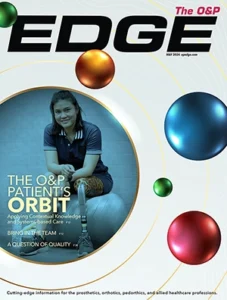Data collected in the United Kingdom found a significant deficit in the number of prosthetists, orthotists, and prosthetic/orthotic technicians and support workers there. The study found that at least 15 percent more prosthetists/orthotists are needed to meet World Health Organization (WHO) standards of care.
In the US, the Bureau of Labor Statistics projects 15 percent growth in the O&P job outlook in the United States from 2022 to 2032. The average growth rate for all occupations in the United States is 3 percent. Are we in the same boat?
The research, commissioned by the British Association of Prosthetists and Orthotists (BAPO) and conducted at the Centre for Biomechanics and Rehabilitation Technologies (CBRT) at Staffordshire University found there are 631 orthotists and 295 prosthetists employed nationwide. However, an additional 142 to 477 prosthetists/orthotists are needed to meet World Health Organization (WHO) standards of care.
“This workforce shortage is worrying,” said Nachi Chockalingam, director of CBRT and a senior author of the study. “With our ageing population, demand for prosthetic and orthotic services will only increase. We urgently need strategies to grow and sustain this profession.”
The study also identified a lack of qualified technicians and support workers to support prosthetist/orthotist teams, with a shortage of 1,133 to 1,803 individuals by WHO benchmarks. Significant recruitment challenges were reported by the National Health Service and private sector employers.
“This landmark report provides the hard evidence we need to take action,” said Nicky Eddison, PhD, lead researcher. “Working with professional bodies, higher education institutions, and the industry, we must inspire the next generation and make prosthetics/orthotics an attractive career choice.”
The report highlighted retention issues as well, with one in five prosthetists/orthotists in the country indicating they may leave the field in the next five years. Key factors driving attrition include lack of career progression, poor work-life balance, and lack of flexibility.
“We need to nurture these professionals so they feel valued and able to thrive throughout their careers, said Peter Iliff, BAPO chair. “BAPO has pledged to implement the report’s recommendations around enhanced educational programs, expanded roles for prosthetic/orthotic technicians and support workers, and greater collaboration to sustain the workforce.”
A 2015 report conducted by Dobson DaVanzo & Associates under the direction of the National Commission on Orthotic and Prosthetic Education (NCOPE) projected the ability of US-based O&P professionals to meet patient demand from 2016 to 2025. It found a rise in demand coupled with a decrease in supply.
“By the end of the ten-year study period (2025), we estimate the demand will continue to increase to 20,504 O&P professionals and the supply will continue to decrease to 12,775 certified professionals. This will result in a demand-to supply ratio of 1.6—indicating that the credentialed supply would need to increase by about 60 percent to meet the growing demand,” the report said.
To read the UK research, “Profile of the UK prosthetic and orthotic workforce and mapping of the workforce for the 21st century,” visit the BAPO website.
To read the NCOPE report, “Projecting the Adequacy of Workforce Supply to Meet Patient Demand: Analysis of the Orthotics and Prosthetics (O&P) Profession,” visit the National Commission on Orthotic and Prosthetic Education website.
To read more about the topic in The O&P EDGE, visit 2020’s “State of the Profession: A Practitioner Population Survey.”




